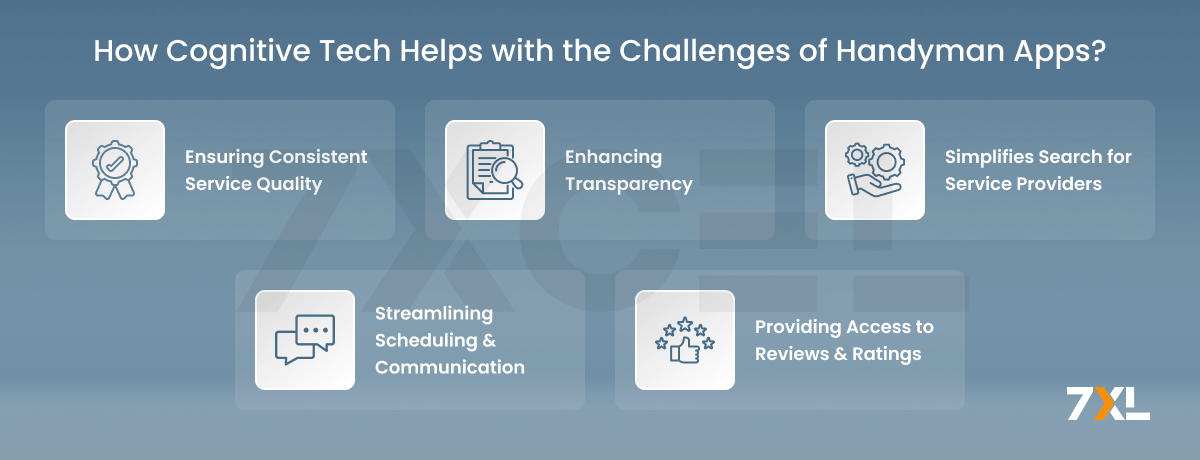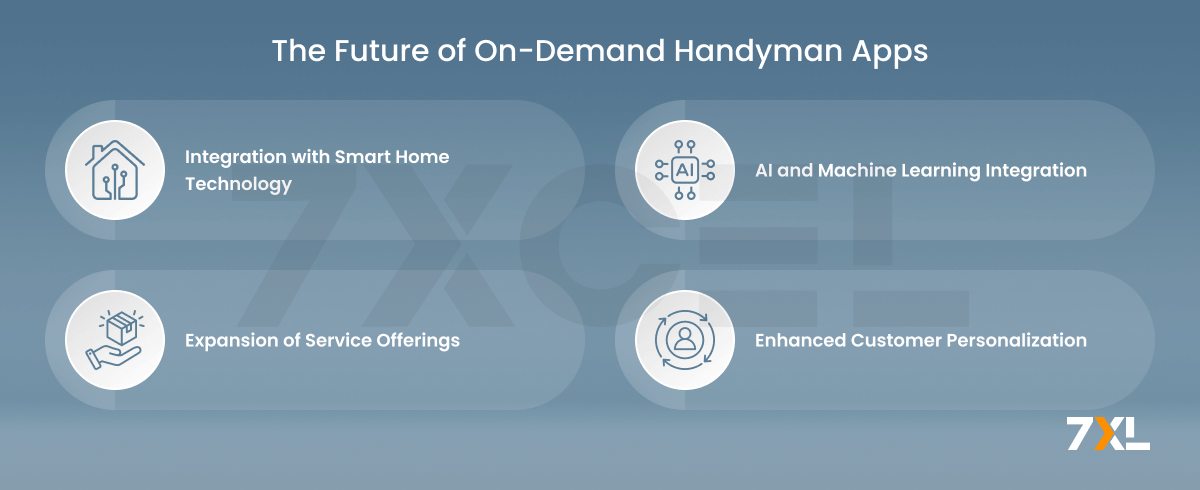Quick Summary:
Developing an on-demand handyman app involves navigating operational complexities and meeting high user expectations. Success relies on effectively managing scheduling systems, vetting professionals, and creating intuitive interfaces. This blog explores the key strategies needed to ensure seamless service delivery and user satisfaction in the competitive digital service landscape.
In this blog, we’re going to discuss📝
The home service industry has long been plagued by inefficiencies and challenges that have hindered its growth and customer satisfaction. reliable service providers to the lack of transparency in pricing and service quality. However, the advent of on-demand handyman apps is revolutionizing the industry, addressing these issues head-on and providing a seamless, user-friendly solution for homeowners and service providers alike.
In this comprehensive blog, we will explore the myriad ways in which on-demand handyman apps are transforming the home service landscape, offering a detailed look at their benefits, features, and the future of this innovative technology.
The State of the Home Service Industry
Before diving into the impact of on-demand handyman apps, it is crucial to understand the current state of the home service industry and the challenges it faces. The home service industry encompasses a wide range of services, including plumbing, electrical work, carpentry, cleaning, and general maintenance.
Traditionally, handyman app development involved a cumbersome process of searching through directories, asking for recommendations, or relying on local advertisements. This method often led to inconsistent service quality and a lack of trust between homeowners and service providers.
Key Challenges in the Home Service Industry
The home service industry, encompassing various services such as plumbing, electrical work, carpentry, and general repairs, faces several significant challenges. These challenges impact both service providers and customers, leading to inefficiencies and dissatisfaction. Here are the key challenges in the home service industry:

Inconsistent Service Quality:
One of the primary issues is the inconsistency in service quality. Homeowners often struggle to find skilled professionals who can deliver high-quality work consistently.
Lack of Transparency:
Pricing and service terms are often opaque, leading to misunderstandings and disputes between customers and service providers.
Difficulty in Finding Reliable Service Providers:
The traditional methods of finding handymen are outdated and inefficient, often resulting in long wait times and inconvenience for homeowners.
Inefficient Scheduling and Communication:
Coordinating schedules between homeowners and service providers can be a logistical nightmare, leading to delays and cancellations.
Limited Access to Reviews and Ratings:
Without access to reviews and ratings, homeowners have no way of knowing the reliability and competence of a service provider before hiring them.
The Features of On-Demand Handyman Apps
On-demand handyman apps have emerged as a game-changer in the home service industry. By providing a platform where services can be easily ordered, scheduled, and controlled, these apps use technology to close the gap between homes and service providers. These applications’ main goal is to make the process of looking for, scheduling, and paying for home services easier, which will help to address the main issues faced by the industry.

1. User-Friendly Interface
Each on-demand handyman software must have an intuitive user interface to be successful. It guarantees that customers may quickly and easily find what they’re looking for on the app, schedule appointments, and navigate about conveniently. Key elements of a user-friendly interface include:
- Simple Navigation: Clear menus and straightforward booking processes help users find and request services effortlessly.
- Responsive Design: The app should work seamlessly across various devices, including smart phones, tablets, and desktops, providing a consistent and smooth user experience.
- Intuitive Layout: An easy-to-understand layout that guides users through the process of selecting a service, scheduling an appointment, and making a payment.
2. Service Provider Profiles
Detailed service provider profiles build trust and help users make informed decisions. These profiles should include:
- Comprehensive Information: Details about the service provider’s experience, skills, certifications, and specialties.
- Ratings and Reviews: Display user ratings and reviews to showcase the quality and reliability of the service providers, helping users choose the right professional for their needs.
- Portfolio: Photos or videos of past work can provide additional assurance of the provider’s capabilities.
3. Real-Time Tracking
Real-time tracking enhances transparency and improves the user experience by allowing users to know the status of their service provider. Key features include:
- GPS Integration: Enable users to track the service provider’s location in real-time, providing peace of mind and reducing uncertainty.
- Arrival Estimates: Provide accurate arrival time estimates based on real-time data and traffic conditions, keeping users informed and updated.
4. Find Nearby Handyman
Finding a nearby handyman quickly and easily is a crucial feature for any on-demand handyman app. This feature ensures users can access services without long wait times.
- Location-Based Services: Use GPS to locate service providers in the user’s vicinity, showing the nearest available handymen.
- Real-Time Availability: Display real-time availability of nearby handymen, allowing users to book the closest and soonest available professional.
- Distance and ETA: Show the distance of the handyman from the user’s location and provide an estimated time of arrival (ETA).
5. Payment Models
Offering flexible payment models caters to different user preferences and enhances convenience.
- Credit/Debit Cards: Accept payments from major credit and debit cards.
- Digital Wallets: Integrate with popular digital wallets like Apple Pay, Google Pay, and PayPal.
- Bank Transfers: Allow direct bank transfers for users who prefer this method.
- Cash on Delivery: Offer the option to pay in cash upon service completion for those who prefer not to use digital payments.
6. Subscription and Membership Plans
- Subscription Services: Offer subscription plans for regular maintenance services, providing convenience for users and steady revenue for the business.
- Membership Tiers: Create membership tiers that offer different levels of benefits and discounts, encouraging users to subscribe for added value.
7. Pay-Per-Job
- Fixed Rates: Offer services at fixed rates for standard jobs.
- Hourly Rates: Provide an option for jobs to be billed on an hourly basis, suitable for tasks that may vary in duration.
8. Integrated Media Capture
Integrated media capture allows users and service providers to share visual information, improving communication and service accuracy.
- Before and After Photos: Allow users and handymen to upload photos and videos before and after the job to ensure clarity and satisfaction.
- Real-Time Media Sharing: Enable users to share photos or videos of the issue they need fixing, helping the handyman assess the job beforehand and bring the necessary tools and parts.
9. Documentation
- Work Documentation: Allow service providers to document their work process through photos and videos, which can be stored in the app for future reference.
- Issue Reporting: Enable users to document and report issues directly through the app using photos or videos, enhancing communication and problem resolution.
10. Workflows
Efficient workflows streamline operations, ensuring that service requests are handled smoothly from booking to completion.
- Automated Job Assignment: Use algorithms to automatically assign jobs to the most suitable and available handyman based on location, skills, and ratings.
- Task Management: Provide tools for handymen to manage their tasks, including viewing upcoming jobs, updating job status, and logging work hours.
11. Booking and Scheduling
Calendar Integration: Integrate a booking calendar that syncs with the handyman’s availability, allowing for easy scheduling and rescheduling.
- Automated Reminders: Send automated reminders to both users and handymen about upcoming appointments to reduce no-shows and cancellations.
12. Service Tracking and Reporting
- Real-Time Updates: Keep users informed with real-time updates on job status, from booking confirmation to job completion.
- Detailed Reports: Generate detailed reports on service performance, including time taken, materials used, and customer satisfaction ratings.
13. Customer Feedback Loop
- Post-Service Feedback: After service completion, prompt users to provide feedback and rate the handyman, ensuring continuous quality improvement.
- Issue Resolution Workflow: Implement a workflow for addressing customer complaints and issues efficiently, ensuring timely resolution and customer satisfaction.
14. Secure Payments
For every on-demand service app, safe and practical payment methods are necessary. Features to include:
- Multiple Payment Options:Give a range of payment options to accommodate varying user preferences, such as bank transfers, digital wallets, and credit/debit cards.
- In-App Payments: Ensure all transactions are processed securely within the app, enhancing user convenience and protecting financial information.
- Payment Confirmation: Send instant payment confirmations and receipts to users.
15. Scheduling and Reminders
Efficient scheduling and timely reminders ensure that appointments are managed smoothly. Key functionalities include:
- Booking Calendar: Allow users to view available time slots and book services accordingly, simplifying the scheduling process.
- Push Notifications: Send reminders for upcoming appointments and notifications for service updates, keeping users informed and helping them manage their schedules.
16. Customer Support
Providing robust customer support is essential for maintaining high user satisfaction. Features to consider:
- 24/7 Support: Assist users with their questions and problems right away by providing 24/7 phone, email, and chat help.
- FAQ Section:extensive FAQ area to assist users in finding prompt solutions to frequently asked concerns and minimize the need for direct support.
17. Quality Assurance
Quality assurance mechanisms ensure that users receive reliable and high-quality services. Essential features include:
- Verified Professionals: Vet and verify all service providers through background checks, certifications, and regular performance reviews.
- Service Guarantees: Offer clear service guarantees and policies for rework or refunds in case of unsatisfactory service, building user trust.
18. User Profiles
Personalized user profiles enhance the overall experience by storing user preferences and history. Key features include:
- Profile Management: Permit users to establish and maintain profiles that contain payment information, contact details, and service preferences.
- Order History: Provide access to past service requests and order history, allowing users to easily rebook services and keep track of their expenses.
- Personalized Recommendations: Use profile data to offer tailored service recommendations.
19. Real-Time Analytics
Real-time analytics provide valuable insights into app performance and user behavior. Important aspects include:
- Performance Monitoring: Track the performance of service providers and app functionality continuously to maintain high service standards.
- User Behavior Analysis: Analyze user interactions to identify trends and improve the overall user experience. Insights from analytics can guide feature enhancements and marketing strategies.
- Custom Reports: Generate detailed reports for business analysis and strategy planning.
20. Marketing and Promotions
Effective marketing and promotions drive user engagement and retention. Key features include:
- Loyalty Programs: Implement loyalty programs to reward frequent users with discounts or exclusive offers, encouraging repeat business.
- Promotional Offers: Provide regular promotional offers and discounts to attract new users & retain existing ones. Personalized promotions based on user behavior can be particularly effective.
- Push Notifications: Send timely notifications about special offers, discounts, or reminders for regular maintenance services to keep customers engaged.

In Need of Home Services App Development Solutions?
Opt for custom on-demand home services app development services from 7xcel, tailored to streamline your everyday household needs.
Benefits of On-Demand Handyman Apps
The benefits of on-demand handyman apps extend to both homeowners and service providers, creating a more efficient & satisfactory experience for all parties involved.

For Homeowners
- Convenience: With just a few taps on their smartphone, homeowners can quickly find and book a handyman for any type of home service. This app is particularly beneficial for busy individuals who do not have the time to search for service providers through traditional methods.
- Quality Assurance: The vetting process and access to reviews ensure that homeowners can trust the quality of service they will receive. Hiring professionals who lack qualifications or credibility is less likely as a result.
- Time-Saving: The streamlined booking process and real-time updates save homeowners time and reduce the stress associated with coordinating home services.
- Cost Transparency: Clear pricing information helps homeowners budget for services and avoid unexpected charges.
For Service Providers
- Increased Visibility: On-demand handyman apps provide service providers with a platform to showcase their skills and services to a larger audience, increasing their visibility and customer base.
- Efficient Job Management: These apps offer tools for managing schedules, communicating with customers, and processing payments, allowing service providers to focus on their work rather than administrative tasks.
- Steady Stream of Jobs: The convenience and accessibility of these apps attract more customers, providing service providers with a steady stream of job opportunities.
- Enhanced Reputation: Positive reviews and ratings can help service providers build a strong reputation, leading to repeat business and referrals.
Overcoming Specific Industry Challenges of On-Demand Apps with Cognitive Tech
Let’s delve deeper into how on-demand handyman apps address specific challenges faced by the home service industry, with a focus on the integration of cognitive technology. Partnering with a specialized Home Service App Development Company can help you build a platform that effectively leverages these advanced technologies.
These experts can assist in integrating AI-driven features such as predictive maintenance, intelligent scheduling, and personalized service recommendations, which can significantly enhance operational efficiency and user satisfaction. By addressing these challenges, your app can provide a seamless and reliable experience for both service providers and customers.

Ensuring Consistent Service Quality
The vetting process employed by on-demand handyman apps is crucial in maintaining high service quality. By conducting background checks, verifying credentials, and assessing skills, these apps ensure that only qualified professionals are listed. In order to find the most qualified service providers, cognitive technology—such as AI-driven algorithms—can improve this process by evaluating massive volumes of data.
Machine learning can predict which service providers are likely to deliver high-quality work based on historical performance data, customer feedback, and other relevant metrics. This fosters confidence between homeowners and service providers, who are incentivized to uphold elevated standards in order to continue operating on the platform.
Enhancing Transparency
Transparency in pricing and service terms is another significant advantage of on-demand handyman apps. Users receive detailed information about the cost of services upfront, eliminating the risk of hidden fees or unexpected charges.
Cognitive technology can further enhance transparency by providing dynamic pricing models that take into account various factors such as market demand, service complexity, and provider availability. Additionally, AI-driven chatbots can assist customers in understanding service terms and conditions, ensuring that all information is clear and accessible.
Simplifying the Search for Reliable Service Providers
On-demand handyman apps make it easy for homeowners to find reliable service providers by aggregating a wide range of services in one place. Cognitive technology can significantly improve the search process by offering personalized recommendations based on user preferences, past behavior, and specific needs.
AI algorithms can analyze user profiles and service histories to match homeowners with the most suitable service providers. This personalized approach not only saves time but also increases the likelihood of finding a provider that meets the homeowner’s exact requirements.
Streamlining Scheduling and Communication
Efficient scheduling and communication are essential for a smooth home service experience. On-demand handyman apps offer built-in scheduling tools that allow users to book appointments at their convenience. Cognitive technology, such as AI-powered scheduling assistants, can optimize appointment times based on the availability of both homeowners and service providers.
These assistants can handle rescheduling and cancellations, reducing the logistical challenges associated with coordinating services. Real-time updates and notifications keep homeowners informed about the status of their service request, while in-app messaging features facilitate clear communication between customers and service providers.
Providing Access to Reviews and Ratings
Access to reviews and ratings is a key feature that sets on-demand handyman apps apart from traditional methods of finding service providers. Cognitive technology can enhance this feature by using natural language processing (NLP) to analyze customer feedback and identify common themes and sentiments.
This analysis can provide deeper insights into the quality of service providers, helping homeowners make more informed decisions. Additionally, AI can detect fake reviews and ensure that the ratings are authentic, maintaining the integrity of the platform.
The Future of On-Demand Handyman Apps
The future of on-demand handyman apps looks promising, with continued advancements in technology poised to further enhance the home service industry. Here are some trends and developments to watch for:

Integration with Smart Home Technology
As smart home technology becomes more prevalent, on-demand handyman apps are likely to integrate with these systems to offer even more convenient and efficient services. For example, a handyman app could connect with a homeowner’s smart home devices to diagnose issues remotely or provide maintenance reminders based on data from connected appliances.
AI and Machine Learning
Artificial intelligence (AI) and machine learning are set to play a significant role in the evolution of on-demand handyman apps. These technologies can be used to match homeowners with the most suitable service providers based on their specific needs and preferences. AI-powered chatbots can also enhance customer service by providing instant answers to common questions and assisting with booking processes.
Expansion of Service Offerings
On-demand handyman apps are likely to expand their service offerings to cover a broader range of home-related needs. This could include everything from interior design consultations to landscaping services, making these apps a one-stop solution for all home maintenance and improvement needs.
Enhanced Customer Personalization
Personalization is becoming increasingly important in the digital age, and on-demand handyman apps are no exception. Future of cost efficient home service app developments may include more personalized recommendations and offers based on a user’s history and preferences. This could involve tailored service packages or discounts for repeat customers.
Conclusion
On-demand handyman apps are revolutionizing the home service industry by offering efficient, transparent, and user-friendly solutions for both homeowners and service providers. These apps streamline the process of finding, booking, and paying for home services, setting new standards for quality and convenience. By addressing issues like inconsistent service quality and lack of transparency, they are paving the way for a more reliable and accessible home service market. As the industry evolves, these apps will continue to enhance customer experiences and play a crucial role in home maintenance and improvement.








